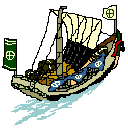 The great age of trade, which was established by the Ryukyu Kingdom throughout East Asia, ended with the appearance of the Western European powers in the 16th century. The amicable trade relationship which had been built with Japan began to show changes. The Shimazu Clan of Satsuma began to approach the Ryukyus with territorial ambitions, eventually culminating in a Satsuma invasion of the Ryukyu Kingdom with a Shogunate sponsored military force in 1609. The Ryukyu Kingdom, weak militarily and having virtually no experience in battle after long peaceful years as a kingdom, was subordinated, without any real resistance, under the Satsuma clan.
The great age of trade, which was established by the Ryukyu Kingdom throughout East Asia, ended with the appearance of the Western European powers in the 16th century. The amicable trade relationship which had been built with Japan began to show changes. The Shimazu Clan of Satsuma began to approach the Ryukyus with territorial ambitions, eventually culminating in a Satsuma invasion of the Ryukyu Kingdom with a Shogunate sponsored military force in 1609. The Ryukyu Kingdom, weak militarily and having virtually no experience in battle after long peaceful years as a kingdom, was subordinated, without any real resistance, under the Satsuma clan.
![]() Shimazu Invasion of the Ryukyus
Shimazu Invasion of the Ryukyus
The Shimazu invasion did not result in the dismantlement of the Ryukyu Kingdom, and its hegemony by Satsuma was concealed from China. Satsuma imposed taxes to be paid in rice and other commodities. The lucrative trade and many other facets of life were controlled by their rules. The Ryukyus were also required to send processions to Edo (Tokyo) to pay obeisance to the Shogunate.
Within this age of disorder, the Ryukyus were fortunate to have had the appearance of bold and able reform leaders such as Choshu Haneji and Saion. Facing up to the reality of Satsuma domination, they tried to save the Ryukyu Kingdom through policies based on cooperation with the Satsuma clan. It was time that the traditional political system of the Ancient Ryukyus ended and the road to a new modern age in the Ryukyu Kingdom opened up.

![]() Reconstruction of the Ryukyu Kingdom
Reconstruction of the Ryukyu Kingdom
The Latter Period Ryukyus was an age of even more advancement and development. The kingdom actively absorbed culture from Japan and China. Harmonizing the diverse cultural influences from Japan and China developed most of the Ryukyuan culture's rich distinctiveness. The traditional Okinawan culture we enjoy today was cultivated in this early modern age.
![]() The Flourishing Industry and Culture of the Latter Period Ryukyus
The Flourishing Industry and Culture of the Latter Period Ryukyus